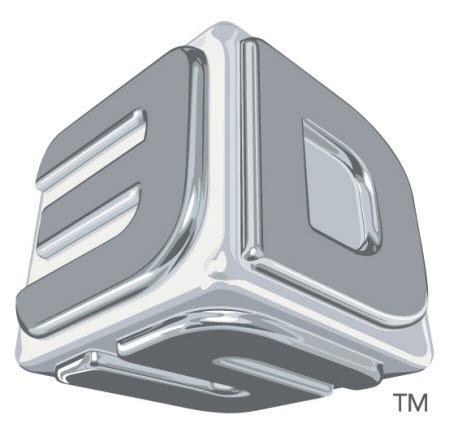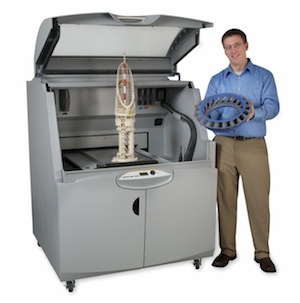Company Profile: 3D Systems

A 3D printed globe on display at 3D Systems’ RAPID 2012 booth. Photo by John Newman.
June 15, 2012
Editor’s note: In an effort to help our readers differentiate the companies providing rapid technologies, we will be profiling them on Rapid Ready Technology. If you are a rapid technology manufacturer or service provider and would like to be considered for a profile, please contact us.
It’s hard to know where to begin when covering a company like 3D Systems. Do you start with the product lines? The problem with that approach is you have to include systems like the ZPrinter line and then you have to go back over the same information a second time when talking about 3D Systems’ acquisitions. Maybe the best place to start is at the very beginning, before the company turned into the juggernaut we’ve become familiar with today.
 In 1986, Chuck Hull patented stereolithography (SLA) and founded 3D Systems. The new technology was exciting, but required a program to help fulfill its vast potential, and so 3D Systems developed the Standard Tessellation Language file format — popularly known as .stl files — which was released as open source and is still in use today. This combination of technology and .stl for CAD was the dawn of the 3D printer era.
In 1986, Chuck Hull patented stereolithography (SLA) and founded 3D Systems. The new technology was exciting, but required a program to help fulfill its vast potential, and so 3D Systems developed the Standard Tessellation Language file format — popularly known as .stl files — which was released as open source and is still in use today. This combination of technology and .stl for CAD was the dawn of the 3D printer era.
“From the beginning 3D Systems worked closely with customers to fully understand the potential applications and uses of 3D printing,” said Cathy Lewis, vice president of global marketing. “These early customer pioneers pushed the technology boundaries which we supported with continued innovation, ultimately revolutionizing product development. Over time we leveraged our technology leadership into rapid manufacturing, optimizing these disruptive and impactful tools across an even broader array of applications, across all industries. And, through our customers, we recognized that multiple technologies and materials would be required to effectively cover their requirements today and in the future.”
With the need to diversify its capabilities in mind, 3D Systems followed up the success of SLA by acquiring the selective laser sintering portfolio (SLS) and developing multi-jet-modeling (ProJet) solutions. Those early investments in additive manufacturing (AM) have borne prodigious fruit, resulting in 7 distinct print technologies and an intellectual property portfolio in excess of 1300 patents. The company reported $230.4 million in revenue for 2011 with a 242% increase of printers sold (based on 2010 sales).
Acquisitions
Beyond the products and services offered by the company, one of the first things anyone in the industry thinks of when they hear the words 3D systems can be summed up in one word: acquisitions. Beginning a little over two years ago, the company has acquired around 24 different companies. In no particular order, some (but by no means all) of those acquisitions include:
- ZCorp
- Alibre
- Bespoke Innovations
- Paramount Industries
- Bits from Bytes
- Quickparts
- Sycode Software Solutions
- My Robot Nation
- FreshFiber
3D Systems at a GlanceCompany: 3D SystemsHeadquarters: Rock Hill, SC Offices: Asia-Pacific, Benelux, Italy Year Founded: 1986 Product Lines and Services: 3D Touch, BotMill, Cube, iPro, ProJet, RapMan, sPro, Voxeljet (distributor), ZPrinter, the 3Dproparts and Quickparts manufacturing services, and Alibre 3D CAD design program. Materials: Metals, photopolymers and thermoplastics. Technologies: Direct metal laser sintering, stereolithography, multi-jet, selective laser sintering and plastic jet printing. Blogs: 3D Systems, Bits from Bytes, Cubify, Freedom of Creation, The 3D Studio |
Rapid Ready is just as curious about the strategy behind the acquisitions as anyone else, so we asked.
“As the industry matured our customers told us that they needed a global, full service resource for on-demand parts printing,” said Lewis. “Whether they had 3D printing technology in-house or not, they want access to it [parts manufacturing] from a brand that they know and trust. Therefore, a number of the acquisitions we’ve made have been to broaden our footprint in the on-demand parts business.”
That explanation doesn’t really cover the acquisition of companies like My Robot Nation, but Lewis gave us her thoughts on the more individual consumer oriented acquisitions as well.
“We are entering the next phase of 3D printing which we call the democratization of creativity. To fully embrace the consumer we need to eliminate the need for CAD expertise, offer coloring book simplicity and gamify the experience,” added Lewis. “The technology assets we’ve acquired have been both opportunistic and strategic, and My Robot Nation brings that game-like user experience to the portfolio so that everyone can begin to participate in the adoption of 3D printing.”
The gist of all that is that 3D Systems means to come at the business of manufacturing and supporting 3D printers from both ends of the spectrum. Until a big box company starts buying 3D printers in bulk, industry will drive the profits of AM. Even so, by offering individual consumers a taste of what 3D printing has to offer, the company intends to increase awareness of the technology. The company says that even the exposure offered by non-AM specific tradeshows (like CES) can bring in new customers, particularly those who are seeing the technology at work for the first time.
The Future
So what does the future hold for 3D Systems? Lewis said they have four key strategies in mind as 3D Systems moves forward. The first is the continued development of its 3D printer lines, including a focus on getting more systems into the professional marketplace. The second is expanding the company’s healthcare solutions, as the healthcare industry use of AM grows into what is basically a separate industry.
The third key is the on-demand parts business, which, as mentioned above, has driven a significant portion of the company’s acquisition strategy. 3D Systems plans on continuing to expand its capabilities in the on-demand market, expanding its global presence. Last, the company intends on moving forward with the consumer market, to democratize use of 3D printing and drive adoption of the technology.
“Whether you’re eight or eighty, the child in all of us is extremely creative and would love to get our hands on some of these amazing tools,” said Lewis. “So that is our mission, to democratize creativity.”
Product Line
In Rapid Ready’s other company profiles, we provide fairly broad coverage of the printers and materials offered by those companies. In the case of 3D Systems, that could be a whole article of its own. Instead of adding another two pages to this post, we’ll offer some links to pertinent parts of the 3D Systems website for you to peruse at your leisure. As defined by 3D Systems, the three main categories of printers offered are personal, professional and production.
Below you’ll find a video featuring 3D Systems newest offering, the ProJet HD 7000.
Sources: Interview with the company, press materials received from the company and additional information gleaned from the company’s website.
Subscribe to our FREE magazine, FREE email newsletters or both!
About the Author
John NewmanJohn Newman is a Digital Engineering contributor who focuses on 3D printing. Contact him via [email protected] and read his posts on Rapid Ready Technology.
Follow DE







